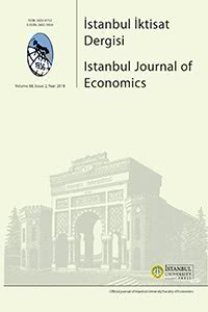YENİ-KEYNESÇİ YAKLAŞIMDA ÜCRET KATILIKLARI
Yeni-Keynesçi Okul'u diğer iktisat okullarından ayıran en temel özellik fiyat ve ücret katılıklarını nominal ve reel ayrımına giderek ele almasından ileri gelmektedir. Ücret ve fiyatların belirlenmesi konusunda önemli olan bu katılıklar, çeşitli teorilerle açıklanmaktadır. Öte yandan Yeni-Keynesçi Okul'un rasyonel beklentiler hipotezi doğrultusunda makro ekonomik değişimleri mikro parametreler uzantısında açıklıyor olması da oldukça önemli bir farklılık yaratmaktadır. Bu doğrultuda çalışmanın amacı Yeni-Keynesçi Okul'un temel özelliklerini açıklamanın ötesinde emek piyasasında reel ve nominal ücret katılıklarında var olan ayrımı ön plana çıkartmaktır.
Anahtar Kelimeler:
Yeni-Keynesçi Okul, Reel Katılıklar, Nominal Katılıklar, Reel Ücret Katılıkları, Nominal Ücret Katılıkları
___
- Akerlof George A.; Janet L. Yellen, (1985), “A Near-Rational Model of the Business Cycle, With Wage and Price Inertia”, The Quarterly Journal of Economics, Vol. 100, Supplement, pp. 823-838
- Akerlof George A., William T. Dickens, George L. Perry, Truman F. Bewley, Alan S. Blinder, (2000), “Near-Rational Wage and Price Setting and the Long-Run Phillips Curve”, Brookings Papers on Economic Activity, Vol. 2000, No. 1, pp. 1-60.
- Arnott Richard J., Arthur J. Hosios, Joseph E. Stiglitz, (1988), “Implicit Contracts, Labor Mobility, and Unemployment”, The American Economic Review, Vol. 78, No. 5, pp. 1046-1066.
- Azariadis Costas, Joseph E. Stiglitz, (1983), “Implicit Contracts and Fixed Price Equilibria”, The Quarterly Journal of Economics, Vol. 98, Supplement, pp. 2-22.
- Ball Laurence, David Romer, (1990), “Real Rigidities and the Non-Neutrality of Money”, The Review of Economic Studies, Vol. 57, No. 2, pp. 183-203.
- Ball Laurence; N. Gregory Mankiw; David Romer; George A. Akerlof; Andrew Rose; Janet Yellen; Christopher A. Sims, (1988) “The New Keynesian Economics and the OutputInflation Trade-Off”, Brookings Papers on Economic Activity, Vol. 1988, No. 1., pp. 1- 82.
- Christofides Louis N., Man Tuen Leung, (2003), “Nominal Wage Rigidity in Contract Data: A Parametric Approach”, Economica, Volume 70, Issue 280, pp. 619-638. Dittmar Robert, William T. Gavin, (2000), “What Do New-Keynesian Phillips Curves Imply for Price-Level Targeting?”, Federal Reserve Bank Of St. Louıs, Vol. March/ April 2000, pp.21-30.
- Dornbusch Rudiger; Stanley Fischer (1993), Macroeconomics, McGraw-Hill, Sixth Edition
- Eren Ercan, Melike Bildirici, (1997), “İktisat Teorilerinde Son Gelişmeler”, İktisat Dergisi, s. 65- 78.
- Froyen Richard T., (2002), Macroeconomics Theories and Policies, Prentice Hall, seventh edition.
- Gordon Robert J., (1990), “What Is New-Keynesian Economics?”, Journal of Economic Literature, Vol. 28, No. 3., pp. 1115-1171.
- Gordon Robert (2006), Macroeconomics, Addison Wesley, 10. baskı.
- Greenwald Bruce; Joseph Stiglitz, (1993), “New and Old Keynesians”, The Journal of Economic Perspectives, Vol. 7, No. 1., pp. 23-44.
- Greenwald Bruce C., Joseph E. Stiglitz, Robert E. Hall, Stanley Fischer, (1988), “Examining Alternative Macroeconomic Theories”, Brookings Papers on Economic Activity, Vol. 1988, No. 1, pp. 207-270.
- Grossman Sanford J., Oliver D. Hart, (1981) “Implicit Contracts, Moral Hazard, and Unemployment”, The American Economic Review, Vol. 71, No. 2, Papers and Proceedings of the Ninety- Third Annual Meeting of the American Economic Association, pp. 301-307.
- Grossman Sanford J., Oliver D. Hart, (1983), “Implicit Contracts Under Asymmetric Information” , The Quarterly Journal of Economics, Vol. 98, Supplement, pp. 123-156.
- Hall Robert, David Papell, (2005), Macroeconomics, Norton & Company, Sixth Edition.
- Heap Shawn P. Hargreaves, (1992), The New Keynesian Macroeconomics: Time, Belief, and Social Interdependence, Edward Elgar Publishing.
- Holmlund Bertil, (1991), “Unemployment Persistence, and Insider-Outsider Forces in Wage Determination”, OECD Economics Department Working Papers No. 92, pp. 1-30.
- Kahn Shulamit, (1997), “Evidence of Nominal Wage Stickiness from Microdata”, The American Economic Review, Vol. 87, No. 5, pp. 993-1008.
- Katz Lawrence F., (1986), “Efficiency Wage Theories: A Partial Evaluation”, NBER Macroeconomics Annual, Vol. 1., pp. 235-276.
- Leslie Derek, (1992), “Insider--Outsider Theory and the Case for Implicit Contracts”, The Economic Journal, Vol. 102, No. 410. , pp. 37-48.
- Lindbeck Assar, Dennis J. Snower, (2001), “Insiders versus Outsiders”, The Journal of Economic Perspectives, Vol. 15, No. 1, pp. 165-188.
- Mankiw Gregory, (1991), “The Reincarnation of Keynesian Economics”, NBER Working Paper No. 3885, pp. 1-11.
- Picard Pierre, (1993), Wages and Unemployment: A Study in Non-Walrasian Macroeconomics, Cambridge University Press.
- Roberts John M., (1995), “New Keynesian Economics and the Phillips Curve”, Journal of Money, Credit and Banking, Vol. 27, No. 4, Part 1., pp. 975-984.
- Romer David, (1993), “The New Keynesian Synthesis”, The Journal of Economic Perspectives, Vol. 7, No. 1., pp. 5-22.
- Snowdon B., Vane H., Wynarczyk P., (2005), A Modern Guide to Macroeconomics, Cheltenham, Edward Elgar.
- Stiglitz Joseph E., (1984), “Theories of Wage Rigidity”, NBER Working Paper Series, No. 1142, pp. 1-70.
- Summers Lawrence H., (1988), “Relative Wages, Efficiency Wages, and Keynesian Unemployment”, The American Economic Review, Vol. 78, No. 2, Papers and Proceedings of the One-Hundredth Annual Meeting of the American Economic Association, pp. 383-388.
- Taylor John B., (1980), “Aggregate Dynamics and Staggered Contracts”, The Journal of Political Economy, Vol. 88, No. 1, pp. 1-23.
- Tobin James, (1998), “Supply Constraints on Employment and Output: NAIRU Versus Natural Rate”, Cowles Foundation Paper 1150, International Conference in Memory of Fausto Vicarelli, Rome, November 21-23, pp. 1-24.
- Yellen Janet L., (1984), “Efficiency Wage Models of Unemployment”, The American Economic Review, Vol. 74, No. 2, Papers and Proceedings of the Ninety-Sixth Annual Meeting of the American Economic Association, pp. 200-205.
- ISSN: 2602-4152
- Yayın Aralığı: Yılda 2 Sayı
- Başlangıç: 1939
- Yayıncı: İstanbul Üniversitesi
Sayıdaki Diğer Makaleler
PERFORMANS ÖLÇÜM YÖNTEMLERİ İLE KURUMSAL KARNE YAKLAŞIMI
Mustafa ÇANAKÇIOĞLU, Mahmut DEMİRBAŞ
YENİ-KEYNESÇİ YAKLAŞIMDA ÜCRET KATILIKLARI
PROF. DR. CUMHUR FERMAN HOCA'MIZIN ANISINA
İ.Ü. İKTİSAT FAKÜLTESİ İŞLETME BÖLÜMÜ ÖĞRENCİLERİNE YÖNELİK BİR PROFİL ÇALIŞMASI
ÇEVRE KORUMACILIĞININ EKONOMİ POLİTİĞİ: MONTREAL PROTOKOLÜ’NDE KOLEKTİF FAALİYET’İN DİNAMİKLERİ
TÜRK BANKACILIK SEKTÖRÜNDE YABANCI GİRİŞİ: RİSK Mİ? FIRSAT MI?
